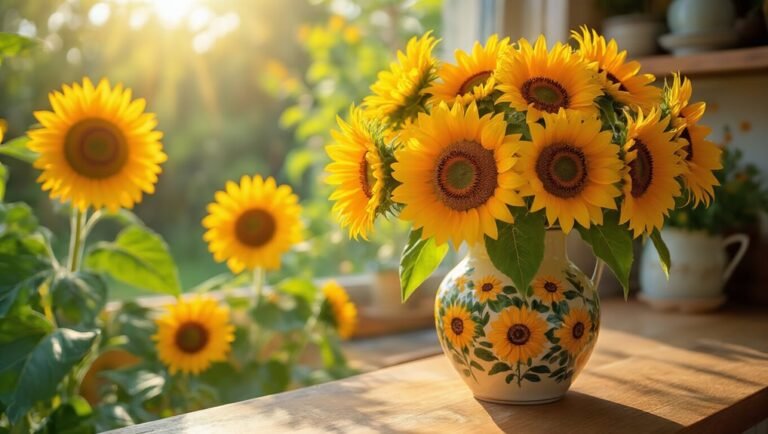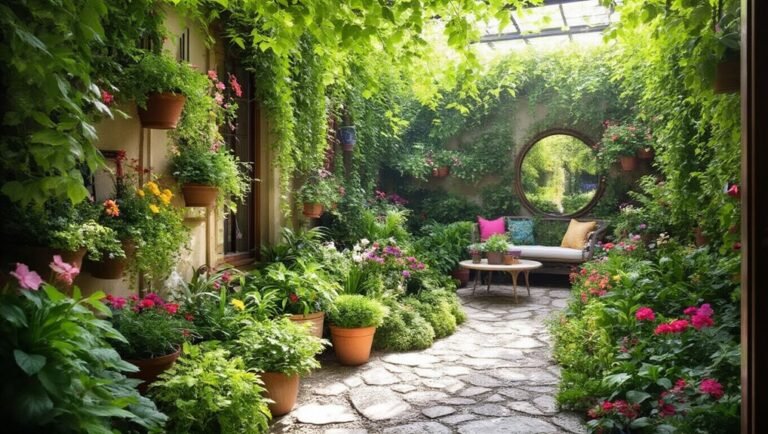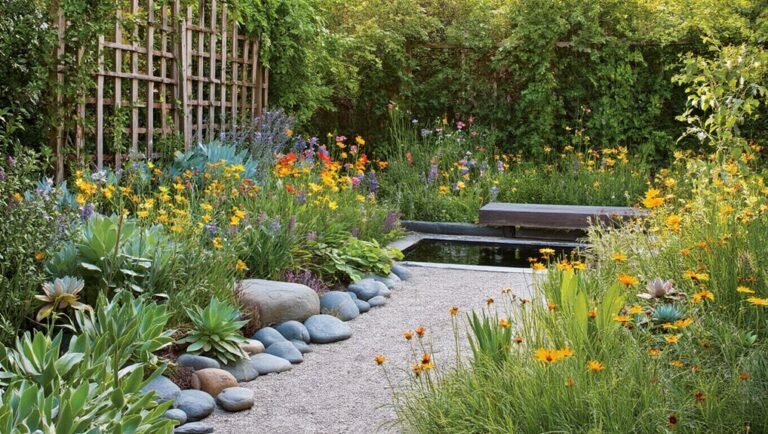The #1 mistake to avoid with your mailbox flower bed is overcrowding plants. When you cram too many into a space, it leads to a cluttered look and hinders their growth. Each plant needs room to thrive, so consider spacing them out properly. This not only enhances visual appeal but also allows for healthy development. With the right balance and care, your flower bed can shine. Let’s explore more tips to create the perfect display!
Key Takeaways
- Overcrowding plants leads to a cluttered appearance and hinders growth, diminishing the overall aesthetic of the mailbox flower bed.
- Neglecting plant height results in a flat-looking arrangement; always place taller plants at the back for depth and visual interest.
- Sticking to one color palette creates a monotonous look; incorporate a variety of colors for a vibrant and engaging display.
- Failing to consider seasonal changes leaves flower beds bare; mix perennials and annuals for continuous blooms throughout the year.
- Using poor quality garden soil affects plant health; ensure good soil quality to support root development and thriving plants.
Understanding the Importance of Your Mailbox Flower Bed
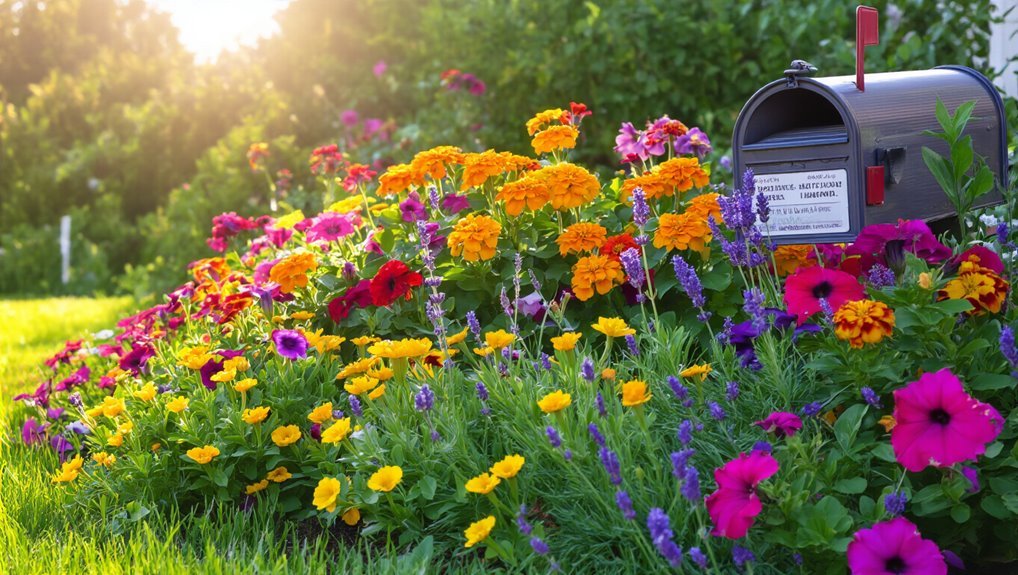
When you consider the first impression your home makes, the mailbox flower bed often gets overlooked, yet it plays a crucial role in enhancing your curb appeal.
This small space can transform your entryway, inviting guests and passersby alike. By choosing vibrant flowers and complementary plants, you create a welcoming atmosphere that reflects your style. A well-maintained flower bed not only draws attention but also showcases your attention to detail. Elevating your display with stylish plant stands can add height and visual interest to your mailbox flower bed, making your arrangement stand out even more.
Incorporating seasonal blooms keeps the area fresh and interesting throughout the year. Plus, a tidy flower bed can mask any wear and tear on your mailbox, making it appear more inviting. Consider using beautiful plant pots to further elevate the look of your mailbox flower bed and introduce additional texture and color to the arrangement.
Common Design Mistakes to Avoid
While designing your mailbox flower bed, it’s easy to make common mistakes that can detract from its appeal. One frequent error is overcrowding plants, which can lead to a cluttered look and hinder growth. Instead, aim for balance and leave enough space for each plant to thrive.
Another mistake is neglecting the height of plants; using the same height throughout can make your arrangement look flat. Incorporate varying heights for visual interest. For healthier beds and improved moisture retention, consider using organic mulching materials to help your plants thrive.
Also, don’t forget about seasonal changes; choosing only summer bloomers can leave your bed bare in other months.
Finally, avoid sticking to just one color palette, as it can create a monotonous appearance. Mixing colors and textures adds character and charm to your flower bed.
To give your plants the best start, make sure to choose quality garden soil that supports strong root development and overall plant health.
Choosing the Right Plants for Your Flower Bed
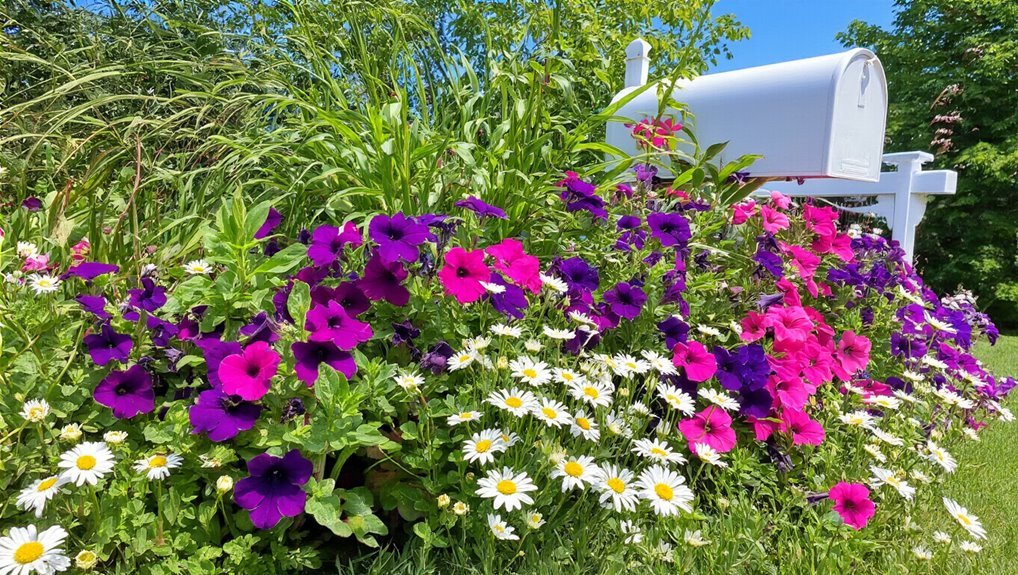
Choosing the right plants for your flower bed can make all the difference in creating an inviting and vibrant display.
Start by considering your local climate and soil conditions. Native plants thrive in your area, requiring less maintenance and water. You might also want to add insect repellent plants such as citronella to help naturally deter pests around your mailbox garden.
Think about color and texture, mixing perennials and annuals for a dynamic look. Don’t forget about height—place taller plants at the back and shorter ones in front to create depth.
It’s also essential to consider the blooming season; selecting plants that bloom at different times will ensure your flower bed remains colorful throughout the year.
Lastly, think about the overall theme of your landscape. By carefully selecting plants that complement each other, you’ll create a beautiful entrance to your home.
For a unique twist and added culinary value, consider incorporating edible flower seeds into your flower bed design, allowing you to enjoy both beauty and taste from your garden.
Planning for Seasonal Changes
As you plan your flower bed, it’s crucial to anticipate seasonal changes that can impact your garden’s appeal. Consider how different seasons affect your plants.
In spring, vibrant blooms can attract attention, while summer heat may require more maintenance. Choose a mix of perennials and annuals to ensure color year-round. To give your plants the nutrients they need in every season, consider starting a compost bin to recycle organic waste into rich compost for your flower beds.
For fall, incorporate plants that showcase autumn hues, like ornamental grasses or chrysanthemums. Winter can be stark, so think about including evergreens or decorative elements that provide visual interest.
Using mulch in your garden is an effective way to help your plants thrive through seasonal changes, as it conserves moisture, regulates soil temperature, and suppresses weeds.
Incorporating Hardscaping Elements
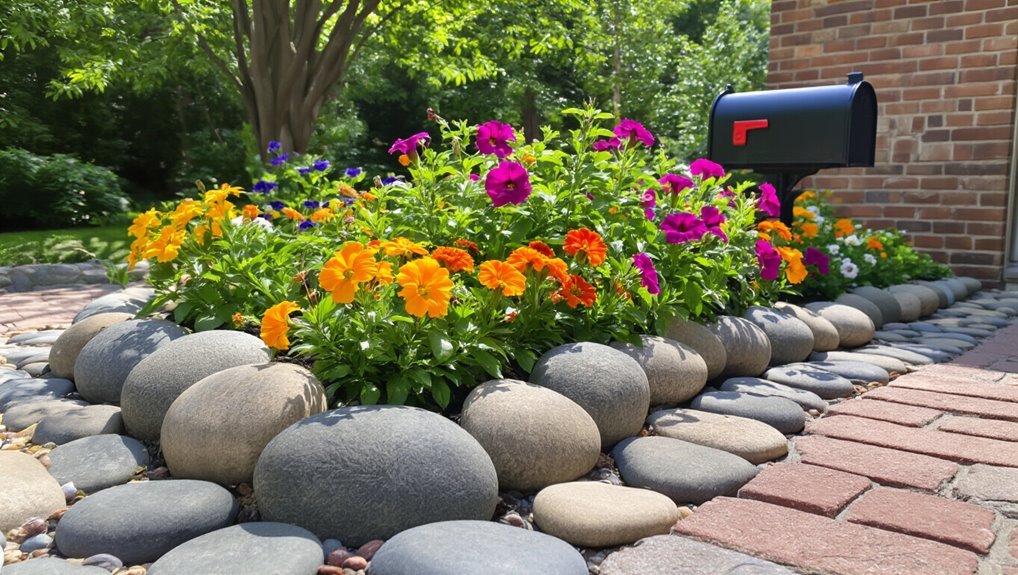
To enhance your mailbox flower bed, consider incorporating hardscaping elements that not only complement your plants but also add structure and interest.
You might include decorative stones, gravel paths, or brick edging to define the space and create a polished look. A small bench or garden statue can serve as a focal point, inviting visitors to pause and appreciate your work.
Raised beds made from wood or stone can elevate your flowers, making them more visible and easier to maintain. Additionally, incorporating a trellis or arbor can support climbing plants, adding vertical interest.
Maintenance Tips for a Thriving Flower Bed
Creating a beautiful mailbox flower bed doesn’t end with the initial design. For your flowers to thrive, you need to commit to regular maintenance.
Start by watering your plants consistently, especially during dry spells. A layer of mulch will help retain moisture and suppress weeds.
Make sure to deadhead spent blooms to encourage new growth and keep the bed looking fresh. Fertilize your flowers according to their specific needs, typically every few weeks during the growing season.
Don’t forget to check for pests and diseases; early detection can save your plants.
Finally, maintain a tidy appearance by trimming back overgrown stems and leaves.
With these tips, your mailbox flower bed will flourish, enhancing your curb appeal all season long.
Frequently Asked Questions
How Can I Create a Theme for My Mailbox Flower Bed?
To create a theme for your mailbox flower bed, choose colors and plants that reflect your style. Consider seasonal blooms, focal points, and complementary accessories. This’ll make your mailbox area inviting and visually appealing.
What Colors Work Best for Mailbox Flower Beds?
For mailbox flower beds, vibrant colors like yellows, reds, and purples grab attention. You can mix warm and cool tones for contrast, creating a lively display that enhances your curb appeal and brings joy to passersby.
Are There Any Flowers That Attract Pollinators?
Imagine vibrant blooms dancing in the breeze, inviting bees and butterflies. Planting lavender, coneflowers, and zinnias will attract pollinators, transforming your garden into a lively haven. You’ll create beauty while supporting nature’s essential workers!
How Do I Prevent Weeds in My Flower Bed?
To prevent weeds in your flower bed, mulch around your plants, regularly check for unwanted growth, and pull out any weeds you see. Keeping the soil healthy and compact also discourages weed growth effectively.
Can I Use Artificial Flowers in My Mailbox Bed?
About 70% of gardeners use artificial flowers for low-maintenance appeal. You can absolutely use them in your mailbox bed! Just ensure they complement your home’s aesthetic and withstand weather conditions for lasting beauty.
Conclusion
In the world of mailbox flower beds, avoiding design blunders can make all the difference. By carefully selecting plants, planning for seasonal changes, and incorporating hardscaping elements, you can create a stunning display that welcomes visitors. Remember, it’s not just about throwing a few flowers in the ground; you’ve got to lay the groundwork for success. With a little TLC and attention to detail, your flower bed will thrive, turning heads and adding charm to your home.
